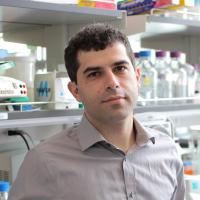Assistant Professor of Neuroscience; Principal Investigator at Columbia's Zuckerman Institute
Recent advances in technology are making it possible for us to look in depth at the more cognitive functions, with the goal of being able to look at an animal’s thoughts in process.

“Memory is the core of the brain,” says Dmitriy Aronov, PhD, a neuroscientist and an incoming principal investigator at Columbia’s Mortimer B. Zuckerman Mind Brain Behavior Institute. “Memory is what makes us such advanced animals. We don’t simply act in response to stimuli, but we combine whatever we’re experiencing right now with our extensive, extensive memory.”
Dr. Aronov studies memory and hopes to understand the complex ways experience translates into action. For example, when you are hungry, you might call to mind your favorite sandwich, consider whether you have all the ingredients, and try to remember whether the local market is still open. In this way, memory influences current behavior — but not directly, because recalling a favorite sandwich does not immediately drive your muscles to run and make it. Instead, we weigh other factors: How easy will it be to prepare? Will eating it impact my diet?
Neuroscience has taught us a lot about the sensory system and the motor system — the parts of the brain that process incoming information and guide how we direct our muscles — but much less about what goes on in between. Memory and other forms of higher thinking are harder to study, in that they are mostly invisible to the outsider.
“But recent advances in technology are making it possible for us to look in depth at the more cognitive functions,” Dr. Aronov says, “really with the goal of being able to look at an animal’s thoughts in process.”
One way his lab does this is by putting rats in virtual reality environments and recording their brain activity. In a typical experiment, he places a rat on a spherical treadmill — picture a computer trackball — surrounded by a projection of a room. Based on current context and recollections of past experiences, the rat figures out where to run to receive a treat of sugar water. Meanwhile, Dr. Aronov records the firing of the rats’ neurons (a type of brain cell) in the hippocampus and entorhinal cortex, two brain areas responsible for memory. In this way Dr. Aronov can control exactly what the animal sees and measure exactly what it does, while simultaneously observing how its brain operates.
In addition to Dr. Aronov’s work with rats, he is developing technologies for monitoring the thoughts of birds in the lab. Rats, he says, are generalists, fairly good at many different tasks. So he wants to look at an animal that’s a genius at a particular behavior, and he has settled on the black-capped chickadee. This bird can hide thousands of pieces of food in a day and know exactly where to find them later. Just like us, the bird is constantly retrieving various pieces of information from memory before acting. Its abilities might shed light on the amazing skills of humans to make complex decisions based on deep experience.
His research also has clear applications to medicine. The brain areas he studies are two of the first to fail in Alzheimer’s disease and dementia. But for the moment, Dr. Aronov is focused on the early-stage research that will help improve our understanding of memory. “Science has often been good at surprising us about which research directions produce the most important applications,” he says. “My drive is to go for the biggest unknowns, and I’m convinced that in the future uncovering them will benefit humanity.”
Roberston Neuroscience Investigator (2018)
Aronov D, Nevers R, Tank DW
Nature.2017 Mar 29
Aronov D, Tank DW
Neuron.2014 Oct 22
Aronov D, Fee MS
PLoS One.2012
Aronov D, Veit L, Goldberg JH, Fee MS
J Neurosci.2011 Nov 9
Veit L, , Fee MS
J Neurophysiol.2011 Oct